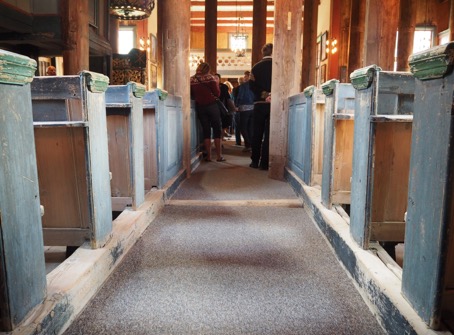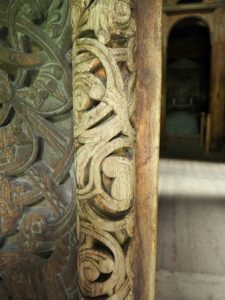Many ancient churches in the world started off as simple wooden structures. Through time and increasing wealth of the Church and communities, most of them were replaced with stone buildings. Wooden churches, also known as stave churches in different parts of Europe, are therefore rare and offer unique insights into our heritage and history. However, little is done to preserve this ever so distinguishing heritage for future generations.

Lom stave church is one the most visited churches in all of Norway. The use of carpets can be a smart move to mitigate mechanical wear and tear to surfaces. But what happens with the floor beneath when we trudge around with our soaked clothes and shoes? Photo: Fredrik Berg.
The latest initiative in this direction comes from the Norwegian Institute for Cultural Heritage Research (NIKU) that investigates the consequences and challenges that arrive with an increased volume of visitors in the stave churches.
The project is conducted in close collaboration with site and church managers, as well as cultural heritage authorities, with the overall aim of mapping needs and challenges about the daily operations and long-term management of the buildings.

Medieval wood carvings on side post in Borgund stave church. Many of us are moved by the patina of age, but the relief will sooner or later be worn out due to daily wear and tear. Photo: Fredrik Berg
There are 28 remaining stave churches in Norway. Apart from being the oldest standing wooden buildings in the country, they are often recognised as Norway’s most significant contribution to religious heritage. The characteristic medieval wooden carvings around many of the portals are unique. With 250 000 annual visitors, they represent a growing and exciting tourism industry. But with their geographical dispersal, complex ownership models, and varied use the need for coordinated and research-based decision making is evident.
The NIKU project will analyse visitors’ experience and gather first-hand data from local sites and their management. The goal of the project is to address how the religious and cultural heritage narrative can be brought forward without affecting the visitors’ experience.
Project leader Fredrik Berg wants to gather an international portfolio with similar projects and cases. If you have any ideas about this project or want to share your experience with Fredrik, you can contact him by email: fredrik.berg@niku.no





Follow us: